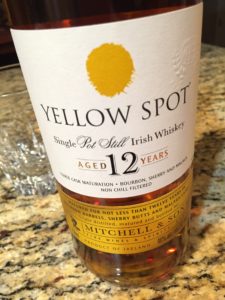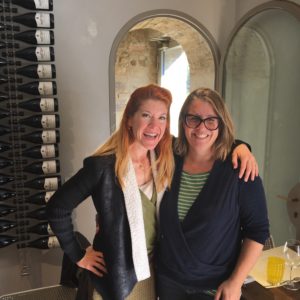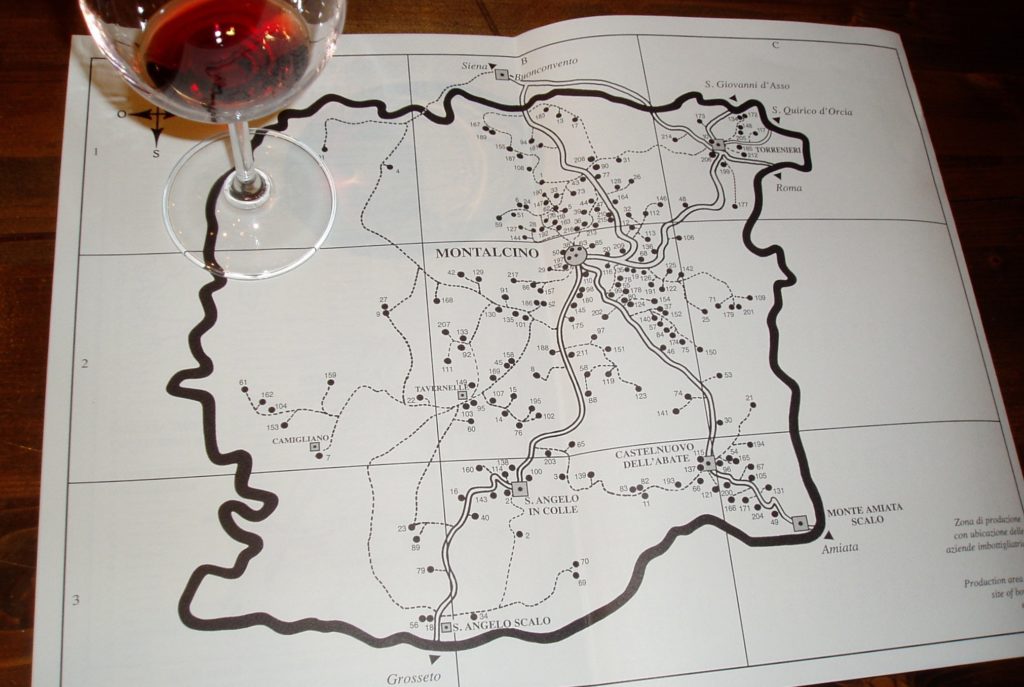Steph & Val are back behind the mic and in the same time zone. We have cocktails, a little Brunello banter, talk history and what makes this wine one of Italy’s finest, while Steph shares some of things she learned in Montalcino. Val breaks out her new Irish whiskey … and shares … and shares. Other things we chatter about this week include Wine Enthusiast’s new podcast, grappa, sushi chef shout out, movie wine trivia, tasting room tales, and a new giveaway! We’re having a great time and hope you’ll pour a glass, click, listen, learn, laugh & sing along … wait … not the singing. Please. Not the singing.
It’s so great to be in the same time zone again, and it is great having a “standard 750mL show” today! Let’s get this party started!
IN OUR GLASSES:
V al: “Well, it’s election day, so by the time this episode airs it will have probably rained frogs and locusts will have swarmed the heartland or something like that. Maybe you’re listening to this from your bunker? Maybe not, and & life in the good ol’ USA is going on as it always does. Either way, I stocked up at the liquor store … because we don’t have enough booze in the house *insert sarcasm here*. I have a brand new bottle of whiskey. That’s whiskey with an “e” because it comes from Ireland.
al: “Well, it’s election day, so by the time this episode airs it will have probably rained frogs and locusts will have swarmed the heartland or something like that. Maybe you’re listening to this from your bunker? Maybe not, and & life in the good ol’ USA is going on as it always does. Either way, I stocked up at the liquor store … because we don’t have enough booze in the house *insert sarcasm here*. I have a brand new bottle of whiskey. That’s whiskey with an “e” because it comes from Ireland.
This is the Yellow Spot, darn it, and it is insane. I believe it’s John’s new favorite. I think they had me at Malaga casks in addition to the Sherry & ex-Bourbon casks they use for maturing the whiskey. This is a single pot still whiskey that was only re-released a few years ago after disappearing in the 1960s, along with the red & blue spot whiskeys. Green spot is still around. There are only about 500 cases of this Yellow Spot released each year.
This is a 12-year old whiskey which means it had to spend a minimum of 12 years in wood. There is such beautiful spice, stone fruit, and almost a butter cream element to this whiskey, with a finish that is quite long and complex.”
Steph: “I can’t believe you’re drinking Yellow Spot because I was wishing that I had some for the show! My house is full of Bourbon and I wanted Irish Whiskey. I was introduced to Yellow Spot a couple years ago at my friend Rob’s house. He knows a ton about whiskey and even apprenticed at a distillery in Tasmania. I’m not surprised that you and John are lovin’-on-it.
“I’m drinking Chartreuse, soda water and slice of lemon for me… in my New Belgium Brewing Fall beer glass!”
DISCUSSION TOPIC: BRUNELLO DI MONTALCINO
Steph just spent some time visiting Brunello producers & thought it would be fun to share a little bit about this special wine.
Some people may not know the difference between the two big “B” words in Italian wine, for example: Brunello & Barolo. Barolo is made with 100% Nebbiolo and comes from the region of Piemonte in Northwestern Italy. We will be talking about Brunello, which comes from a delimited growing area in Tuscany. It’s made with 100% Brunello, a clone of the Sangiovese. Because of the nearly brown color of the Sangiovese clones as harvest time approached, these grapes were given the name “Brunello.”
So, Brunello is a wine style and also the name of the grape! It is produced in the Montalcino growing area which lies lies 70 miles south of Florence. Here the Brunello vines are treated to a uniquely beneficial microclimate in which nearby Monte Amiata creates its own weather patterns. The dry summer heat of this area is offset by precipitation and cool evening breezes thanks to Monte Amiata. This allows the Brunello to ripen fully, which they would have less ability to do in a less amiable, cooler, northern environs. Between well-draining soils and warmer climate, the powerful Brunello ripens quickly and is one of the first to be harvested of all the Sangiovese clones.
Steph also got to talk with Lorella at Banfi about the Horizon vinification system that they created which allows them to combine the control of temperature controlled tank fermentation but with additional organoleptic characteristics imparted by barrel fermentation. This audio and photo is on our Patreon page.
While the history of the Brunello is not as extravagant as the wine is famous, it is still quite significant. Early wines from Montalcino were known as Vermiglio, but were all blends of red and white grapes, and documentation reaches back as far as the 15th century. In 1685, however, the more famous wines from this region were the Moscadello. These were mentioned in Francesco Redi’s dithyrambic work Bacco in Toscana (Bacchus in Tuscany).
Later, in the late 1800s, the famous Ferruccio Biondi Santi proliferated the single-varietal experiment of his uncle Clemente which was to produce a pure 100% Sangiovese. They worked with early Sangiovese clones, in order to achieve a single-varietal wine that would be able to last 100 years in a bottle. Ferrucio’s son, Tancredi, carried on the tradition of trying to achieve his father’s (and grandfather’s) dream of the long-lived wine, and the tradition of pursuing a wine capable of long-term aging, He was actually one of the contributors to the development of the appellation standards for Brunello di Montalcino.
But even after World War II, during which time wines world-wide were not prolific, there were still only a handful of Brunello producers. Throughout the 1950s, these wines were little-known outside the “expert” circles; only a few thousand bottles of Brunello a year made their way into the hands (and glasses) of wine lovers.
It was during the 1960’s the notorious wine quality revolution and an economic expansion in Italy encouraged investments in Tuscan wine production and enabled vineyard replantings as well as vinification techniques and facilities. Innovations in stainless temperature-controlled tanks and expanded use of smaller wood barrique became the standard. Brunello di Montalcino earned the DOC appellation status in 1966,(a good year!) and subsequently the Consortium of Brunello di Montalcino was created in 1967. By 1980, as the wines from Montalcino production areas were becoming popular, Brunello di Montalcino earned its DOCG status.
Rules for the Production
Brunello di Montalcino (DOCG)
100% Brunello (Sangiovese Grosso Clone)
Minimal aging time in wood: 2 years
Minimal aging time in bottle: 4 months (6 months for the Riserva)
Bottling must take place in the production area
Minimum alcohol by volume: 12.5%
Available for sale 5 years after the harvest (6 years for the Riserva)
Rosso di Montalcino (DOC)
Also a wine with excellent structure, but more drinkable at a younger age, fresher, still elegant, yet a perfect food companion. It is often said one should drink Rosso di Montalcino while waiting for the Brunello to age.
100% Brunello
Bottling must take place in the production area
Minimum alcohol by volume: 12.0%
Available for sale 1st of September of the year following the harvest
What is interesting also are these other wines that can be produced in Montalcino that are nothing like Brunello!
Moscadello di Montalcino (DOC)
This is a wine from white grapes made into still, sparkling and late harvest styles, and by definition is meant to be a dessert wine. Yet it is woven just as tightly into the history of Montalcino, as documented by the poet Redi: “Quel si divino e leggiardetto Moscadelletto di Montalcino” (Those divine and light Moscadelletto di Montalcino).
100% Moscato Bianco
Bottling must take place in the production area
Minimum alcohol by volume: 10.5% for still and frizzante; 11.5% for late harvest
Vinified into natural, frizzante (lightly bubbly), meant to be drunk young;
Late harvest, sweet dessert wines which can age for some time, and are available for sale 1st of January after the 2nd year after the harvest.
Sant’Antimo (DOC)
In order to classify other wines from this production area (other than Brunello, Rosso, and Moscadello) the Sant’Antimo denomination was created in 1996. Sant’Antimo covers red and white wine production, including a Novello (released 6 November every year, and only drinkable until 2 February the following year), and Vin Santo (from white grapes) and Sant’Antimo Occhio di Pernice (from red grapes).
Varietals vary depending on the wine. Reds and whites can be made with international grapes (Cabernet, Merlot for reds, Chardonnay, Sauvignon Blanc for whites, etc.)
FACTOID:
What is the difference between Italian Grappa and it’s cousin French Marc (pronounced mahr and rhymes with car)?
First, here’s what they have in common:
- They are both distilled brandy from the by-product of wine making called grape pomace – the grape skins, stems, and seeds.
- Their differences are Grappa is traditionally clear and unaged. However, there are now 4 categories of Grappa – young, cask conditioned, aromatic and aromatized.
- Marc is (usually) aged in barrel, which makes it a little smoother, softer and richer. Marc de Champagne, however, us usually not aged in barrel. Again, all of this is relative to the producer’s intended style.
One more cool tidbit: You can evaluate Grappa by rubbing a small amount on the back of your hand and sniffing for impurities that are released in the vapor. If the aroma is pleasant, then it is a well-made Grappa.
WINORADAR:
We have to talk about the new Wine Enthusiast podcast. How exciting is this? Many of you will be surprised to find out where some of the country’s finest wine writers found their love for wine. Like like many of us, it started with the wine cooler. The first episode introduces us to the editors, including our guest from our last episode, Executive Editor Susan Kostrzewa, and the digital editor Jameson Fink whom you may recognize from his podcast, Wine Without Worry. We also find out where the wine coolers went – ever wonder why they disappeared? They tell us in the first episode. We also want to thank Cara from WE PR, who even gave us a shoutout in Social Media to help our little podcast out!
SHOUTOUTS:
Val: “Can I just give a shoutout to Michael, my sushi chef over at Sushi o Sushi last week? He’s very curious in learning about wine and actually handed over his phone to me so I could navigate subscribing him to our podcast on his Android. Gotta say, the iPhone is a heck of a lot friendlier with the native podcast app, but I figured out if you just go to google play music then bing, bang, boom – there it is. Also found him Society of Wine Educators’s nifty wine app as well.”
Steph: “Thank you Lorella Carresi, PR & Communication Manager for Banfi. You spent nearly three hours with us at Castello Banfi in Montalcino. You have so much enthusiasm to share with the wine world!
 “Also, applause for Laura Grey, Estate Manager at Il Palazzone. She and I made a connection six years ago, but it wasn’t over her Brunello. It was the olive oil that the small estate also produces in addition to their two red wines, a Brunello and a Rosso. Here’s a clip from Laura sharing a funny wine story.”
“Also, applause for Laura Grey, Estate Manager at Il Palazzone. She and I made a connection six years ago, but it wasn’t over her Brunello. It was the olive oil that the small estate also produces in addition to their two red wines, a Brunello and a Rosso. Here’s a clip from Laura sharing a funny wine story.”
PATREON LOVE:
Thank you so much to our Patreon supporters! Sending out some Patreon Love to:
- Jeff E from the hilarious drinking show, We Like Drinking
- Meg from South Dakota!
- Clay from Arizona!
- Jon in California!
- Andrew in Illinois!
To learn more and become a Winetastic Listener Supporter for only $1 per month, check out our patron only content at https://www.patreon.com/winetwofivepodcast!
For all listeners who pledge $5/month or more we are sending out our custom govino logo glasses! These are a fun new Patreon Perk!
At the $10/month level you’ll receive a set of two glasses. At the $20/month level you’ll receive a set of four!
We thank you for being a vital part of the W25 listening and sipping community. (All glasses will be mailed out after credit cards are charged on the first of the month; you can stop/change your pledge level at any time after the first month.) We hope you’ll post pictures of your #W25Challenge entries using your new govino logo glasses, too!
By the way, current and new patrons at all levels will be entered into a contest we’re having that ends on 1 January 2017. The prize should be in our hands by next week, but either way you win because you’re helping our show! Also, there’s a recipe that pairs with this week’s episode on the Patreon site for our supporters as well.
SHARE THE LOVE:
Val: Please share Wine Two Five with your friends and online community, and we certainly appreciate all your involvement and feedback. Leave us a burning wine question or comment on speakpipe. iTunes love is always appreciated in the form of a glowing iTunes review as well. For your listening pleasure, whether IOS or Android, we are also on iHeartRadio! So share our fun W25 community with all the wine lovers in your life!
Come play with us on our FB page, Twitter, Pinterest & YouTube, Google+ spaces if you’d like. Also, if you want to build your collection of wine books (like this one, also available on kindle!) or accessories please check out the online store also located on our website!
Connect with Val on Twitter @WineGalUnboxed and on the Vino With Val FB page, and on instagram as Vino with Val.
You can find Steph on Twitter @Albarellosoap and on the AlbarelloSoap FB page, and check out the videos on the Albarello YouTube channel! Steph is also on instagram as the Wine Heroine.
Steph: One more thing … don’t forget to use the #W25Challenge when you are trying new wines and drinks to win an opportunity to co-host the show with us. Until next week …. Cheers!
Check out the entire episode:
